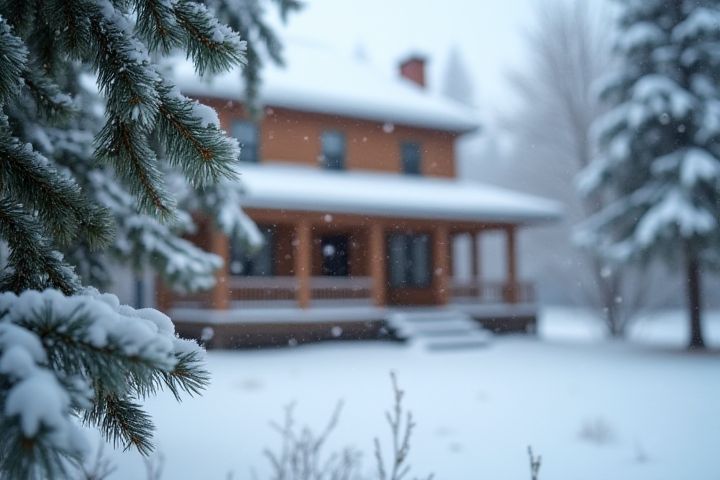
Winterizing your house is essential to prevent damage from freezing temperatures and to enhance energy efficiency. First, focus on insulating pipes to prevent them from bursting, especially in unheated areas like basements and attics. Check and seal any gaps around windows and doors to keep heat in and cold out, which will also save on heating costs. It's advisable to service your heating system, ensuring it operates efficiently for the winter months. Finally, consider cleaning gutters and downspouts to prevent ice dams and water damage during heavy snowfall.
Should I Winterize My House
Insulate pipes to prevent freezing
Insulating your pipes is crucial to prevent freezing during winter months, which can lead to costly water damage and repairs. Heat loss from uninsulated pipes can decrease the efficiency of your heating system, driving up energy costs. Focusing on areas like attics, basements, and crawl spaces where pipes are more exposed can provide effective protection. Consider using foam sleeves or pipe insulation tape, which can significantly enhance your home's winter readiness.
Seal gaps around windows and doors
Winterizing your house is essential for maintaining energy efficiency and comfort during colder months. Sealing gaps around windows and doors prevents drafts, which can lead to increased heating costs and reduced indoor temperatures. Consider using weatherstripping or caulk to effectively seal these gaps, ensuring a snug fit that keeps your home warm. This simple yet impactful measure enhances insulation, contributing to a more stable and inviting living environment.
Clean gutters to prevent ice buildup
Winterizing your house is crucial for maintaining its integrity during cold months. Cleaning gutters ensures that water can flow freely, preventing ice buildup that could lead to damaging ice dams on your roof. You should check for debris like leaves and twigs that can obstruct drainage, as well as ensure the downspouts direct water away from the foundation. By taking these proactive steps, you protect your home from potential water damage and costly repairs in the spring.
Inspect and service the heating system
Inspecting and servicing your heating system is essential for an efficient winterization process. Regular maintenance ensures optimal performance, reducing energy consumption and preventing costly breakdowns during frigid temperatures. Additionally, checking for leaks or blockages can improve indoor air quality and enhance comfort levels throughout your home. Prioritize this step to ensure a warm and safe environment during the winter months.
Reverse ceiling fan direction
Winterizing your house is essential for energy efficiency and comfort, especially when it comes to heating costs. One effective strategy is to reverse the direction of your ceiling fan; running it clockwise at low speed helps to circulate warm air that collects near the ceiling back down into the living space. This can lead to a noticeable drop in heating bills, potentially saving you up to 15% according to energy experts. Remember to check the fan's switch, usually located on the motor, to effortlessly adjust its direction before the cold season hits.
Install storm windows and doors
Installing storm windows and doors can significantly enhance your home's insulation during the winter months. By reducing drafts and minimizing heat loss, these features can lower your heating costs by up to 20%. Properly sealed storm windows and doors also protect against moisture and severe weather conditions, extending the lifespan of your existing windows and doors. For optimal benefits, ensure that these installations are done before the first frost, guaranteeing your home stays warm and energy-efficient all winter long.
Check roof for leaks or damage
Winterizing your home involves inspecting the roof for leaks or damage, which is crucial to prevent water infiltration during heavy snow or rain. Look for missing shingles, cracked tiles, or damaged flashing, as these can lead to significant issues if left unresolved. Consider replacing or repairing any affected areas to enhance your roof's integrity and protect your home. Taking these proactive measures helps ensure a well-maintained and safe environment throughout the winter months.
Use weatherstripping on doors and windows
Weatherstripping is essential for winterizing your house, as it can reduce energy loss by up to 30%. Properly sealing your doors and windows not only helps maintain a consistent indoor temperature but also lowers your heating costs significantly. Consider using high-quality materials like foam, felt, or vinyl, which can last several seasons when installed correctly. Investing time in weatherproofing can lead to substantial savings on your energy bills during harsh winter months.
Trim trees and branches near house
Winterizing your house involves essential tasks, such as trimming trees and branches that are near your home. Overhanging limbs can pose risks during winter storms, leading to potential damage to your roof or windows. Regular maintenance not only protects your property but also enhances safety by preventing falling debris. You should assess the condition of your trees, ensuring to cut back any close branches before the winter weather sets in.
Test smoke and carbon monoxide detectors
Winterizing your home should include checking and testing smoke and carbon monoxide detectors, as these devices are essential for your safety. Replace batteries in detectors every six months to ensure they function properly during winter months when heating systems are in use. According to the National Fire Protection Association, you should install smoke alarms inside each bedroom, outside each sleeping area, and on every level of your home, including the basement. Ensuring your detectors are operational can significantly reduce the risk of fire hazards and carbon monoxide poisoning during the colder season.
